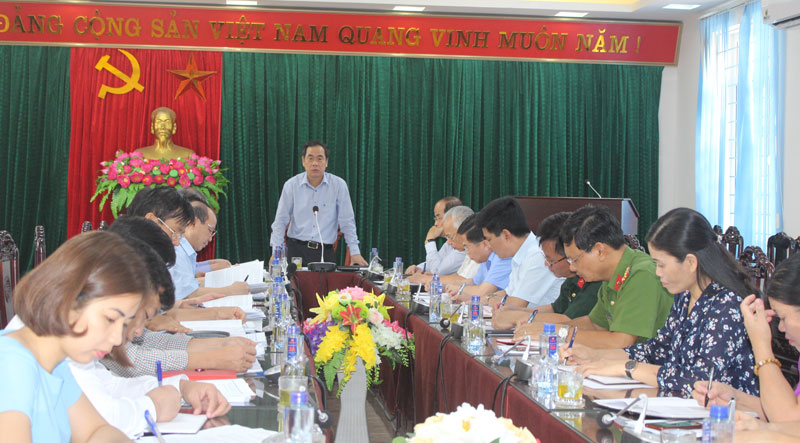
HBO – A delegation of the provincial Party Committee’s Standing Board led by the committee’s Vice Secretary and Chairman of the provincial People’s Committee Nguyen Van Quang inspected the implementation of the Resolution of the 16th provincial Party Congress, 2015-2020 tenure, by the Party Committee of Tan Lac district during a trip in late July.

Vice Secretary of the provincial Party
Committee and Chairman of the provincial People’s Committee Nguyen Van Quang
delivers his speech concluding the inspection.
In implementing the Resolution of the 16thprovincial Party Congress and the Resolution of the 23rddistrict Party Congress, during the past half of tenure, the Party Committee of
Tan Lac district has led the execution of all tasks towards set targets. Half
way of the tenure, the district has achieved more than 50 percent of the
workload for 16 out of 17 set targets, of which six targets have been completed
and surpassed.
The district posted an average annual
economic growth of 13.7 percent, up 171 percent compared to the goal set by the
resolution, while per capita income has increased to more than 38 million VND,
equivalent to 77 percent of the set target. The economic structure is making
positive shifts. The district has four communes meeting new-style rural area
criteria, meeting 44 percent of the target. The rate of household poverty is
reducing at an average 3.1 percent a year. The local political security and
social order and safety has been ensured, and defence has been maintained.
Concluding the inspection, Vice
Secretary of the provincial Party Committee and Chairman of the provincial
People’s Committee Nguyen Van Quang underlined the key tasks that the district
Party organization should focus on doing in the time ahead, in order to fulfill
all the set targets.
Specifically, the district’s Party
organization should put forth feasible measures to bolster socio-economic
development, focusing on increasing revenues for the State budget to serve as
counterpart capital for implementing the national target programme on building
new-style rural areas and to invest in sustainable poverty reduction work.
He noted that as agriculture will continue to
play the main role in the local economic structure, the district should try to
build concentrated farming areas towards expanding hi-tech agricultural
production.
The official also urged Tan Lac district to
create favourable conditions to attract investment in resorts and eco-tourism
as well as in building industrial clusters./.
Hoa Binh province is undergoing a dynamic transformation amid Vietnam’s national digital transition. Building on Poliburo’s Resolution No. 57-NQ/TW on breakthroughs in science, technology, innovation, and national digital transformation, the province has rolled out a wide range of practical action plans. A standout initiative is the "Digital Literacy for All” movement, an effort to ensure that no one is left behind in the digital era.
Hoa Binh province is undergoing a dynamic transformation in the wake of the national digital transformation movement. Building on Resolution No. 57-NQ/TW of the Politburo on breakthroughs in science, technology, innovation, and national digital transformation, the province has implemented a wide range of practical action plans. A standout initiative is the "Digital Literacy for All” movement ambitious effort to ensure that no one is left behind in the digital age.
With a spirit of unity and proactive problem-solving, the Party Committee, the government and the people of Dong Lai Commune (Tan Lac District) have made great strides in implementing the resolutions of the 24th Party Congress of the commune for the 2020 - 2025 term. Focusing on leadership and practical actions, the commune has brought the Party’s resolutions into daily life, creating strong impacts and pushing the local development forward.
Amid the nationwide push for digital transformation, young people in Hoa Binh Province are stepping up as dynamic pioneers, applying technology to enhance Youth Union operations and expand the reach of youth-led initiatives. Through creativity and adaptability, Youth Union organizations at all levels have introduced a series of practical solutions, contributing to modern governance and community development.
In recent years, An Nghia commune, located in Lac Son district, has stepped up administrative reform, focusing on improving the quality and efficiency of its single-window service unit for receiving and processing administrative procedures. These improvements have helped create favourable conditions for local residents and organisations to handle administrative procedures, contributing to the commune’s broader socio-economic development.
The Prime Minister-approved master plan to develop the multi-use value of forests ecosystems through 2030, with a vision to 2050, aims to improve the management and sustainable use of forest resources, create jobs, increase incomes, and improve the living standards of ethnic minorities, people in mountainous and remote areas, forest workers and those living near forests.



